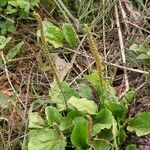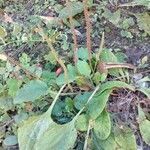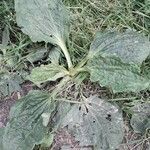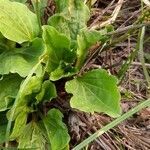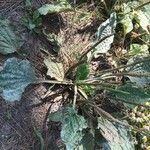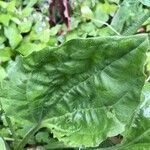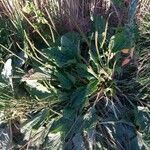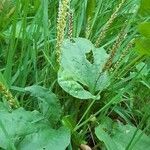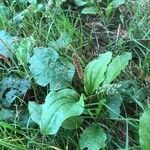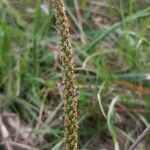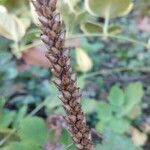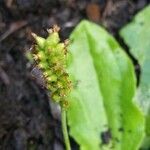Hairy or occasionally glabrous short-lived perennial herb with stout caudex and many large adventitious roots, occasionally with persistent, well-developed primary roots. Lvs all radical, rosulate; petiole 1-20-(30) cm long, broadened at base, channelled. Lamina to 21 × 16 cm, ovate to suborbicular (somewhat narrower in small-leaved plants), generally puberulent, at least on the main veins beneath, sometimes glabrate or glabrous, entire or remotely dentate; main veins 5-7; base truncate to cordate in more typical large-leaved plants but often cuneate to attenuate in smaller, and especially narrower-leaved forms; apex rounded to obtuse. Scapes c. 5-80 cm long, not ribbed, generally hairy, at least towards base, sometimes glabrous or nearly so. Spikes dense, 1.5-c. 30 cm long, narrow-cylindric. Bracts ovate, > calyx, herbaceous and keeled, glabrous, sometimes with membranous margin. Sepals 1.5-2.1 mm long, broad-ovate; keel green and herbaceous, otherwise sepal scarious. Corolla tube = or slightly < calyx; lobes 1-1.3 mm long, ovate to elliptic-ovate, reflexing. Stamens glabrous, long-exserted. Style long-exserted, puberulent. Capsule usually 2.5-4 mm long, broad-ellipsoid, 6-16-seeded. Seeds 1-1.8 mm long, slightly trigonous but also rather irregular, rugose, dark red, brown, dark brown or black.
Herbs, perennial. Roots numerous, fibrous. Leaves basal, pubescent to subglabrous; petiole 1-10(-26) cm; leaf blade broadly ovate to broadly elliptic, 3-18(-30) × 2-11(-21) cm, herbaceous to papery, veins (3 or)5 or 7, base cuneate, subrounded, or cordate, ± decurrent onto petiole, margin remotely dentate to subentire, apex acute to obtuse. Spikes narrowly cylindric to cylindric, 1-20(-40) cm, usually interrupted basally; peduncle 2-18(-45) cm, pubescent; bracts broadly ovate-triangular, 1.2-2 mm, glabrous or pubescent at apex, keel broad and thick. Flowers sessile. Sepals 1.5-2.5 mm, glabrous or ciliolate, keel not extending to apex, apex rounded; lower sepals elliptic to broadly elliptic; upper sepals broader. Corolla white, glabrous; lobes narrowly ovate, 1-1.5 mm, patent to reflexed. Stamens adnate only to near base of corolla tube, exserted; anthers purplish or white, ellipsoid, 1-1.2 mm. Pyxis subglobose, ovoid, or broadly ellipsoid, 2-3 mm, circumscissile at or just below middle, with (8-)12-24(-34) seeds. Seeds yellowish brown, ovoid, ellipsoid, or rhomboid, 0.8-1.2 mm, angled, ventral face prominent to slightly flat; cotyledons parallel to ventral side. Fl. Jun-Aug, fr. Jul-Sep. 2n = 12, 18, 24.
An extremely variable, usually robust, glabrous or pubescent herb, with short stout erect stem and numerous adventitious roots.. Leaves borne in a rosette, spirally arranged; blade ovate, elliptic or rarely rounded, (1-)10-20(-30) cm. long. (0.7-)5-9.5(-17) cm. wide, rounded at the apex, entire, sinuate or irregularly toothed, 3-9-nerved at the base, abruptly narrowed at the base into a petiole usually ± equalling the blade, 1-20 cm. long.. Inflorescences spicate, the spikes nearly always cylindric, almost invariably simple, (0.5)10-15(-70) cm. long; peduncles (l-)7-15(-40) cm. long; bracts 1-2.5 mm. long, acute, brownish with a brown keel.. Sepals broadly elliptic to rounded, 1.5-2 mm. long and wide, keeled.. Corolla greenish-or yellowish-white, 2-4 mm. long; lobes elliptic-ovate, ovate or narrowly triangular, 1-1.25 mm. long, obtuse or acute.. Anthers at first lilac, later whitish or yellowish.. Capsule globose or subconic, 2-3 mm. long, 3-34-seeded.. Seeds brown to dark brown or olivaceous with lighter belt on back, ellipsoidal or angular, 1-1.7 mm. long, 0.8 mm. wide, the ventral side more convex than the dorsal side; hilum lighter.. Fig. 1/1, 2.
Fibrous-rooted perennial from a short, stout, erect caudex, glabrous or rather inconspicuously hairy, especially below; lvs with broadly elliptic to broadly ovate or cordate-ovate blade ± abruptly contracted to the well defined petiole, the blade entire or irregularly toothed, mostly 4–18 × 1.5–11 cm, 1.3–2(–3) times as long as wide, strongly 3–several-nerved, the nerves diverging at the base of the blade, ± parallel to the margin; petiole only seldom anthocyanic at base; scapes 5–25 cm; spikes dense but narrow, less than 1 cm thick, commonly 5–30 cm long, essentially glabrous; bracts broad, ovate-obtuse, mostly 2–4 mm, with a prominent, acute keel and thin margins; sep ovate, obtuse, the rounded keel about as wide as the scarious margins; cor-lobes ca 1 mm or less, reflexed after anthesis; stamens 4, exsert; fr rhombic-ovoid, 2.5–4 mm, circumscissile near or a little below the middle; seeds 6–30, 1 mm, strongly reticulate; 2n=12, 24. Native of Eurasia and probably also parts of N. Amer., naturalized throughout the U.S. and s. Can. in lawns, roadsides, and waste places. (P. asiatica)
Perennial herb, glabrous or pubescent. Leaves with petiole 1–20 (–35) cm long, broadened at base; lamina ovate to broadly ovate-elliptic, (4–) 10–20 (–30) cm long, (2.5–) 5–10 (–17) cm wide, abruptly narrowed at base, entire to irregularly bluntly toothed, rounded at apex, 5–7-veined. Scapes to 80 cm tall. Inflorescence cylindrical, (1–) 10–15 (–30) cm long, often sparse towards base. Sepals broadly ovate, 1.5–2.5 mm long. Corolla tube c. equal to calyx; lobes ovate, c. 1.5 mm long, greenish or yellowish white. Anthers almost globose, c. 1 mm long. Ovary 2-locular, with 2–8 ovules per locule; style 4–5 mm long. Capsule broadly ellipsoidal, 4–5.5 mm long, 8–16-seeded. Seeds c. 2 mm long, brown, irregularly angular.
Perennial herb, 0.10-0.45 m high. Leaves in a basal rosette, elliptical, ovate to obovate, up to 400 x 125 mm, glabrous; petioles flattened, up to 200 mm long. Inflorescences in spikes up to 135 mm long; many scapes per rosette, up to 300 mm long; bracts usually glabrous to pubescent, apex acute. Calyx lobes elliptical, ± 2 x 1 mm, winged, acute. Corolla lobes deltoid, ± 1.2 x 0.7 mm, acute. Flowering time Sept.-Mar. Fruit an ellipsoid capsule, ± 3 x 2 mm. Seeds rounded-tetrahedral, 15-25 per capsule, black to dark brown, 1.2 x 0.9 mm, hilum scar at apex small.
A herb. It keeps growing from year to year. It has a short, stout rootstock. It has a ring of leaves near the ground. The leaves are ribbed. They are soft and oval shaped. The leaves narrow into the stalks. The leaf stalks are fairly long and have wings. The leaves can be 30 cm long by 15 cm wide. The leaves have 5-9 easy to see veins running along them. The flower stem is leafless and as long as or shorter than the leaves. The flowers are in a dense spike. This can be as long as or longer than its stem.
Leaves in a basal rosette spirally arranged, petiolate; lamina (1.5) 5–30 (40) × (0.5) 3–10 (17) cm., ovate to elliptic or rarely subcircular, entire sinuate or irregularly dentate, 3–9-veined at the base, usually glabrous or rarely pubescent, with the apex rounded to subobtuse, abruptly narrowed into the petiole; petiole 3–38 cm. long, usually as long as the lamina or shorter, cauliculate, flexible, glabrous or rarely pubescent.
Perennial herb; scape up to 0.45 m high. Leaves in a basal rosette, petiolate; blade elliptic, ovate or obovate, 70-400 x 24-125 mm, glabrous or with scattered hairs. Flowers: spikes 40-135 mm long; corolla greenish; Oct.-Jun. Seeds 15-25 per capsule.
Inflorescence spicate, the spikes nearly always cylindrical, almost invariably simple, (0.5) 10–15 (70) cm. long, 3–8 mm. in diam.; flowers densely to loosely arranged.
Thinly hairy, tufted perennial to 45 cm. Leaves ovate, petiolate, ribbed, sometimes woolly in axils. Flowers in elongate spikes, scattered below, whitish.
Perennial herb, very variable, usually robust, glabrous or pubescent, growing with a short straight erect stem, with numerous adventitious roots.
Scape (1) 7–15 (47) cm. long, 1–4 mm. in diam., erect or ascending, striate, glabrous or sometimes with short, appressed or ascending hairs.
Rosulate perennial herb. Leaves petiolate, elliptic, ovate or obovate, with scattered hairs. Seeds 15-25 per capsule. Flowers greenish.
Corolla tube c. 2 mm. long, glabrous; lobes 1–1.25 mm. long, lanceolate to ovate or narrowly triangular, acute to subacute, glabrous.
Sepals 1.5–2 (2.5) mm. long, almost boat-shaped, usually equal, glabrous, green with narrow scarious margins, midrib prominent.
Seeds 1–1.7 mm. long, ellipsoid or ellipsoid-trigonous, with the ventral side more convex than the dorsal.
Stamens 2–3 mm. long, exserted; anthers at first lilac, later whitish or yellowish.
Capsule 2–3 (5) mm. long, ovoid to globose or subconical, (3) 8–16 (34) seeded.
Bracts 1–2 (2.5) mm. long, ovate, glabrous, midrib distinct.
Ovary globose; pistil longer than the flower, hairy.
